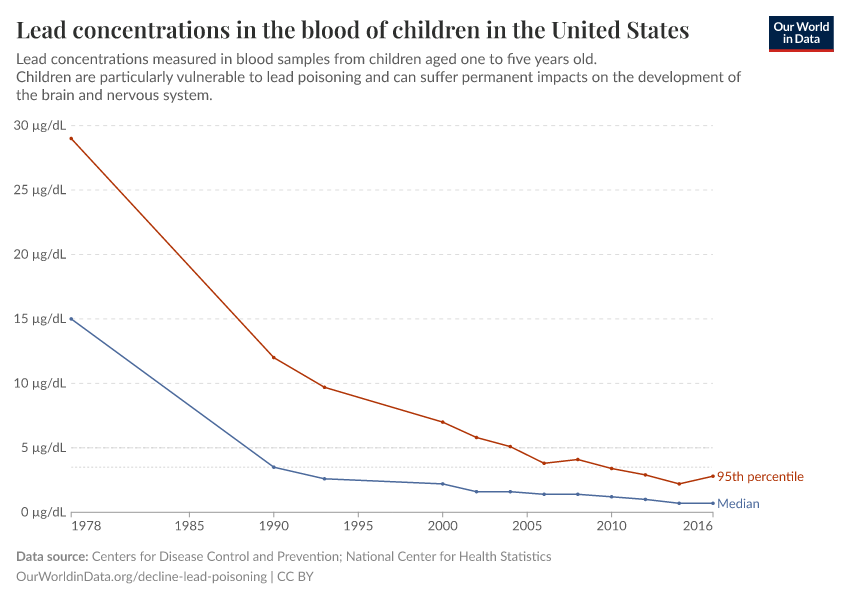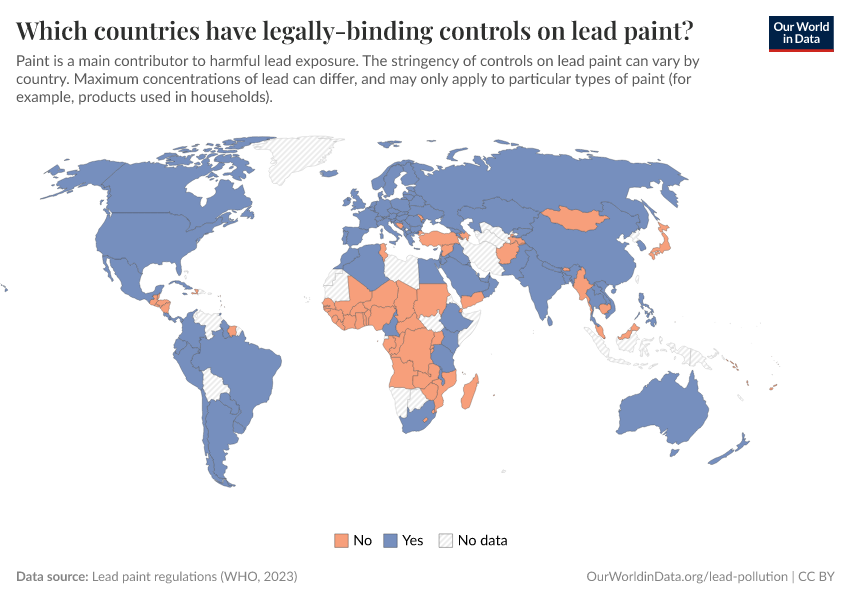Around one-in-three children globally suffer from lead poisoning. What can we do to reduce this?
Estimates suggest that around every third child in the world suffers from lead poisoning. What can we do to reduce this?
Lead poisoning is estimated to account for about 1% of the global disease burden.1
This is a large burden for a problem that gets very little attention. On an individual level, being exposed to lead in the environment can hinder a child’s brain development: it can result in a reduction in IQ; cognitive function; and has been linked to higher levels of antisocial behavior.2 These impacts are thought to be largely irreversible.
It’s not just damaging for individuals. It also comes at a large economic cost for society at large. Impacts on brain development, cognitive function, and productivity affect a country’s output and earning potential. Researchers estimate that in some countries, the costs of lead exposure are equivalent to as much as 6% of GDP.3
The cost of the problem is large because the numbers affected are too: figures compiled by UNICEF, Pure Earth, the Institute for Health Metrics and Evaluation, and the World Health Organization estimates that lead poisoning affects around every third child in the world.
Yet we spend so little on it. Just $7 million of philanthropic spending per year.4
For this reason, GiveWell – the charity evaluator that tries to identify where donor money could make the most difference – made its first large grant to a lead charity in 2021. In its assessment it notes that “Lead exposure appears to receive little philanthropic attention relative to the burden it imposes and may be a tractable problem to make progress on” and that “reducing lead exposure is one of the promising areas we identified as part of GiveWell's work investigating giving opportunities to assist governments in low- and middle-income countries in the design and implementation of effective public health regulations.”
If we compare the amount of funding that lead pollution receives compared to other health problems, we see that it gets very little. GiveWell’s evaluation concluded that tobacco receives ten times the amount of philanthropic funding that lead does. But smoking contributes just three times more harm.
We have already made a lot of progress against lead poisoning
We know that it is possible to tackle lead poisoning because we’ve already made a lot of progress against it.
The largest source of lead throughout most of the 20th century was leaded gasoline which was widely used across the world. As a result, lead became widespread across the world’s cities, polluting the air and contaminating soils. People were exposed to high concentrations. We know this from measurements of the concentrations of lead in their blood.
From the 1970s, countries began to phase out the use of leaded gasoline. This developed into an incredibly successful global health campaign: by 2021 every country in the world had banned it. We look at the phase-out of leaded gasoline in more detail in our related article.
Many countries have taken further steps to reduce exposure to lead. Most high-income countries have either banned, or strongly regulated the use of lead in paints. They have also often banned the use of lead pipes and where old lead pipes remained in place they add anti-corrosives to the water supply to prevent lead from contaminating it.5
As a result, many countries have seen a large decline in levels of lead poisoning. Between 1978 and 2016, the median level of lead in the blood of children in the US fell by 95%. We see this in the chart. Many other countries have achieved similarly large reductions.6
How we continue to make progress: acting on what we know
The phase-out of leaded gasoline had a positive impact across the world. But many countries are yet to tackle the other sources of lead pollution.
There are two possibilities to continue making progress.
First, countries can replicate public health measures that we know can make a difference. The elimination of leaded paint is one such measure. Unfortunately, most low-to-middle income countries do not have any controls on the levels of lead used in paints, as the map shows. As a result, the majority of paints sold in these countries have extremely high levels of lead – well above the regulatory limits that are set in higher-income countries.
Lead is used in paints as a pigment to add color, to prevent corrosion and to help it dry more quickly. But there are non-toxic alternatives that work just as well. Why are these alternatives not used? There may be some initial up-front cost for paint manufacturers to change their formula. This is why government regulations are important: paint manufacturers would not have to fear that they’d lose out to cheaper competitors. But there is also evidence that alternatives do not need to be costly. Some manufacturers in these countries already use lead-free paint, and it’s not more expensive than other paints on the market.7
Measures may not have been adopted simply due to a lack of awareness. In a country with many health challenges, it’s easy to see why lead poisoning – which is a hidden problem that has an effect often only years later – could be easily missed.
One project that is trying to raise awareness of this challenge with policymakers and paint formulators is the Lead Exposure Elimination Project (LEEP). In its first year it has driven policy change in Malawi; and made progress with several others.
How we continue to make progress: understanding more about what we don’t know
Second, to make progress in the future we need to identify what we don’t know about lead pollution. There are many potential sources of lead exposure that we don’t understand well.
People can be exposed to lead through lead piping, batteries, and electronic waste.8 In some countries studies have even found very high levels of lead in cooking spices.9
The problem is that we don’t know the contribution of each of these sources. It will probably vary from location to location. Without good data on this, it could be easy for us to miss an important source of pollution.
We need better data on all of the potential sources of lead so we make sure that we don’t leave any unaddressed.
In its assessment profile, Givewell acknowledges that this evidence-gathering is an important focus of its funding. But that is also a risk of its effectiveness:
“A substantial proportion of this funding will be allocated to gathering evidence on likely sources of lead exposure in particular locations. But we are unsure whether the identified sources of lead exposure will be able to be addressed cost-effectively.”
Being honest about what is known and what is still uncertain is important if we’re to make progress against this problem, and weigh up its costs and benefits relative to other important causes.
Acknowledgements
I would like to thank Lucia Coulter and Clare Donaldson, at the Lead Exposure Elimination Project, for insights and support of this project. Thanks also to Max Roser for feedback and suggestions on drafts of this text.
Keep reading at Our World in Data
How the world eliminated lead from gasoline
Explore our page on lead pollution
Endnotes
The Institute for Health Metrics’ Global Burden of Disease study estimates that in 2019, lead exposure was responsible for just over 0.9% of global disability-adjusted life years (DALYs).
Attina, T. M., & Trasande, L. (2013). Economic costs of childhood lead exposure in low-and middle-income countries. Environmental health perspectives, 121(9), 1097-1102.
Lanphear et al. (2005) Low-Level Environmental Lead Exposure and Children’s Intellectual Function: An International Pooled Analysis. Environmental Health Perspectives.
Ericson, B., Dowling, R., Dey, S., Caravanos, J., Mishra, N., Fisher, S., ... & Fuller, R. (2018). A meta-analysis of blood lead levels in India and the attributable burden of disease. Environment International, 121, 461-470.
Attina, T. M., & Trasande, L. (2013). Economic costs of childhood lead exposure in low-and middle-income countries. Environmental health perspectives, 121(9), 1097-1102.
GiveWell (2021). Pure Earth — Support for Reducing Lead Exposure in Low- and Middle-Income Countries.
The failure of this policy in Flint, Michigan in 2014 brought this old problem of lead pollution back into the limelight. Thousands of households were exposed to high levels of lead after the city changed its water source. It failed to apply corrosion inhibitors to it, meaning lead from the city’s pipes leaked into the water supply, exposing thousands of young children to lead poisoning.
We see this in data in Germany, for example. Hagner, C. (1999). Historical review of European gasoline lead content regulations and their impact on German industrial markets.
And in Swedish children: Schütz, A., Attewell, R., & Skerfving, S. (1989). Decreasing blood lead in Swedish children, 1978–1988. Archives of Environmental Health: An International Journal, 44(6), 391-394.
World Health Organization (2020). Global elimination of lead paint: why and how countries should take action. Technical brief. Geneva.
Ericson, B., Hu, H., Nash, E., Ferraro, G., Sinitsky, J., & Taylor, M. P. (2021). Blood lead levels in low-income and middle-income countries: a systematic review. The Lancet Planetary Health, 5(3), e145-e153.
Gleason, K., Shine, J. P., Shobnam, N., Rokoff, L. B., Suchanda, H. S., Ibne Hasan, M. O. S., ... & Mazumdar, M. (2014). Contaminated turmeric is a potential source of lead exposure for children in rural Bangladesh. Journal of Environmental and Public Health, 2014.
Cite this work
Our articles and data visualizations rely on work from many different people and organizations. When citing this article, please also cite the underlying data sources. This article can be cited as:
Hannah Ritchie (2022) - “Around one-in-three children globally suffer from lead poisoning. What can we do to reduce this?” Published online at OurWorldinData.org. Retrieved from: 'https://ourworldindata.org/reducing-lead-poisoning' [Online Resource]BibTeX citation
@article{owid-reducing-lead-poisoning,
author = {Hannah Ritchie},
title = {Around one-in-three children globally suffer from lead poisoning. What can we do to reduce this?},
journal = {Our World in Data},
year = {2022},
note = {https://ourworldindata.org/reducing-lead-poisoning}
}Reuse this work freely
All visualizations, data, and code produced by Our World in Data are completely open access under the Creative Commons BY license. You have the permission to use, distribute, and reproduce these in any medium, provided the source and authors are credited.
The data produced by third parties and made available by Our World in Data is subject to the license terms from the original third-party authors. We will always indicate the original source of the data in our documentation, so you should always check the license of any such third-party data before use and redistribution.
All of our charts can be embedded in any site.

